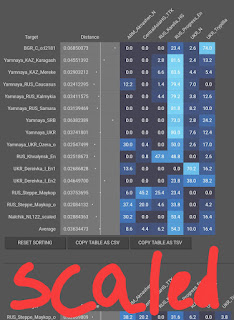New details are emerging about the Lernagog 1 site which was discovered in 2017 by an Armeno-Japanese team. Radiocarbon dates show that it is the oldest Neolithic site in South Caucasus and can be qualified as Early or Middle Neolithic (8-7th millennium BCE) Until the discovery of this site the advent of food producing in South Caucasus was mostly dated after 6200 BCE, known as Shulaveri- Aratashen- Shomutepe culture.
Tuesday, May 28, 2024
Lernagog 1 - a new Neolithic site in Republic of Armenia near Talin.
Saturday, May 18, 2024
I tested qpadm models about the Core Yamnaya origins.
We have one sample from north Caucasus PG2004 which is similar to so called BP group of Caucasus Lower Volga cline.
Saturday, May 4, 2024
The Kurgan builders.
The Caucasus Lower Volga cline (CLV) having both south Caucasian and Eastern European foragers ancestry is a genetic term. The material cultures behind this term were variable but they had one important common feature. Virtually all the samples from CLV cline were found from kurgans. Kurgan is an artificial mound, a tumulus on top of the grave. A kurgan could harbor a single or multiple graves. Given that it requires a lot of manpower it was usually built for elite persons. Smaller kurgans also existed. Other prominent features of kurganic burials in Pontic Caspian steppe were the red ochre, the raised knee position etc. The origins of this tradition are uncertain, and the dates of the oldest kurgans debated but what is well known now that it expanded with Eneolithic (is equal to Chalcolithic) pastoralists (4500-3500bc) who had the CLV ancestry, replacing older local hunter's flat grave tradition. Besides kurgans, we know that those people had a patrilocal and exogamic culture.









